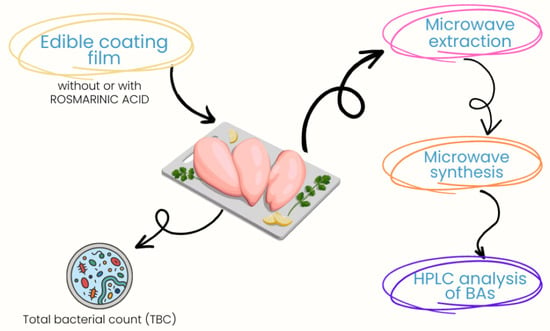Determination of Biogenic Amine Level Variations upon Storage, in Chicken Breast Coated with Edible Protective Film
Abstract
1. Introduction
2. Materials and Methods
2.1. Reagents and Instruments
2.2. Preparation of Film-Forming Emulsions
2.3. Characteristics of the Edible Coatings
2.4. Preparation of Chicken Breast Coated with Chitosan Films
2.5. Total Bacterial Count (TBC) in Meat Samples
2.6. The Lipid Oxidation Level Determination (TBARS Test)
2.7. Biogenic Amine (BA) Analysis with the HPLC Technique
3. Results and Discussion
Results of Selected Parameter Determination in Meat Samples
4. Conclusions
Supplementary Materials
Author Contributions
Funding
Institutional Review Board Statement
Informed Consent Statement
Data Availability Statement
Conflicts of Interest
References
- Sánchez-Ortega, I.; García-Almendárez, B.E.; Santos-López, E.M.; Amaro-Reyes, A.; Barboza-Corona, J.E.; Regalado, C. Antimicrobial edible films and coatings for meat and meat products preservation. Sci. World J. 2014, 2014, 248935. [Google Scholar] [CrossRef]
- Mehdizadeh, T.; Langroodi, A.M. Chitosan coatings incorporated with propolis extract and Zataria multiflora Boiss oil for active packaging of chicken breast meat. Int. J. Biol. Macromol. 2019, 141, 401–409. [Google Scholar] [CrossRef]
- Miller, K.; Reichert, C.L.; Schmid, M. Biogenic amine detection systems for intelligent packaging concepts: Meat and meat products. Food Rev. Int. 2023, 39, 2543–2567. [Google Scholar] [CrossRef]
- Umaraw, P.; Munekata, P.E.S.; Verma, A.K.; Barba, F.J.; Singh, V.P.; Kumar, P.; Lorenzo, J.M. Edible films/coating with tailored properties for active packaging of meat, fish and derived products. Trends Food Sci. Technol. 2020, 98, 10–24. [Google Scholar] [CrossRef]
- Bharti, S.K.; Pathak, V.; Alam, T.; Arya, A.; Basak, G.; Awasthi, M.G. Materiality of edible film packaging in muscle foods: A worthwhile conception. J. Package Technol. Res. 2020, 4, 117–132. [Google Scholar] [CrossRef]
- Song, D.-H.; Hoa, V.B.; Kim, H.W.; Khang, S.M.; Cho, S.-H.; Ham, J.-S.; Seol, K.-H. Edible Films on Meat and Meat Products. Coatings 2021, 11, 1344. [Google Scholar] [CrossRef]
- Liu, Y.; He, Y.; Li, H.; Jia, D.; Fu, L.; Chen, J.; Zhang, D.; Wang, Y. Biogenic amines detection in meat and meat products: The mechanisms, applications, and future trends. J. Future Foods 2024, 4, 21–36. [Google Scholar] [CrossRef]
- Omer, A.K.; Mohammed, R.R.; Ameen, P.S.M.; Abas, Z.A.; Ekici, K. Presence of biogenic amines in food and their public health implications: A review. J. Food Prot. 2021, 84, 1539–1548. [Google Scholar] [CrossRef] [PubMed]
- Ruiz-Capillas, C.; Herrero, A.M. Impact of biogenic amines on food quality and safety. Foods. 2019, 8, 62. [Google Scholar] [CrossRef] [PubMed]
- Dala-Paula, B.M.; Custódio, F.B.; Gloria, M.B.A. Health concerns associated with biogenic amines in food and interaction with amine oxidase drugs. Curr. Opin. Food Sci. 2023, 54, 101090. [Google Scholar] [CrossRef]
- Pop, O.L.; Pop, C.R.; Dufrechou, M.; Vodnar, D.C.; Socaci, S.A.; Dulf, F.V.; Minervini, F.; Suharoschi, R. Edible films and coatings functionalization by probiotic incorporation: A review. Polymers 2020, 12, 12. [Google Scholar] [CrossRef]
- Jeevahan, J.J.; Chandrasekaran, M.; Venkatesan, S.P.; Sriram, V.; Joseph, G.B.; Mageshwaran, G.; Durairaj, R.B. Scaling up difficulties and commercial aspects of edible films for food packaging: A review. Trends Food Sci. Technol. 2020, 100, 210–222. [Google Scholar] [CrossRef]
- Hassan, B.; Shahid Chatha, S.A.; Hussain, A.I.; Zia, K.M.; Akhtar, N. Recent advances on polysaccharides, lipids and protein-based edible films and coatings: A review. Int. J. Biol. Macromol. 2018, 109, 1095–1107. [Google Scholar] [CrossRef]
- Moura-Alves, M.; Esteves, A.; Ciríaco, M.; Silva, J.A.; Saraiva, C. Antimicrobial and antioxidant edible films and coatings in the shelf-life improvement of chicken meat. Foods 2023, 12, 2308. [Google Scholar] [CrossRef]
- Kumar, S.; Mukherjee, A.; Dutta, J. Chitosan based nanocomposite films and coatings: Emerging antimicrobial food packaging alternatives. Trends Food Sci. Technol. 2020, 97, 196–209. [Google Scholar] [CrossRef]
- Wang, H.; Ding, F.; Ma, L.; Zhang, Y. Edible films from chitosan-gelatin: Physical properties and food packaging application. Food Biosci. 2021, 40, 100871. [Google Scholar] [CrossRef]
- Abdollahzadeh, E.; Nematollahi, A.; Hosseini, H. Composition of antimicrobial edible films and methods for assessing their antimicrobial activity: A review. Trends Food Sci. Technol. 2021, 110, 291–303. [Google Scholar] [CrossRef]
- Yildirim, S.; Röcker, B.; Pettersen, M.K.; Nilsen-Nygaard, J.; Ayhan, Z.; Rutkaite, R.; Radusin, T.; Suminska, P.; Marcos, B.; Coma, V. Active packaging applications for food. Compr. Rev. Food Sci. Food Saf. 2018, 17, 165–199. [Google Scholar] [CrossRef] [PubMed]
- Elsabagh, R.; Ibrahim, S.S.; Abd-Elaaty, E.M.; Abdeen, A.; Rayan, A.M.; Ibrahim, S.F.; Abdo, M.; Imbrea, F.; Smuleac, L.; El-Sayed, A.M.; et al. Chitosan edible coating: A potential control of toxic biogenic amines and enhancing the quality and shelf life of chilled tuna filets. Front. Sustain. Food Syst. 2023, 7, 1177010. [Google Scholar] [CrossRef]
- Kaur, R.; Gupta, T.B.; Bronlund, J.; Kaur, L. The potential of rosemary as a functional ingredient for meat products—A review. Food Rev. Inter. 2023, 39, 2212–2232. [Google Scholar] [CrossRef]
- Sirocchi, V.; Devlieghere, F.; Peelman, N.; Sagratini, G.; Maggi, F.; Vittori, S.; Ragaert, P. Effect of Rosmarinus officinalis L. essential oil combined with different packaging conditions to extend the shelf life of refrigerated beef meat. Food Chem. 2017, 221, 1069–1076. [Google Scholar] [CrossRef]
- Huang, M.; Wang, H.; Xu, X.; Lu, X.; Song, X.; Zhou, G. Effects of nanoemulsion-based edible coatings with composite mixture of rosemary extract and ε-poly-L-lysine on the shelf life of ready-to-eat carbonado chicken. Food Hydrocoll. 2020, 102, 105576. [Google Scholar] [CrossRef]
- Tsironi, M.; Kosma, I.S.; Badeka, A.V. The effect of whey protein films with ginger and rosemary essential oils on microbiological quality and physicochemical properties of minced lamb meat. Sustainability 2022, 14, 3434. [Google Scholar] [CrossRef]
- Tkaczewska, J.; Jamróz, E.; Kasprzak, M.; Zając, M.; Pająk, P.; Grzebieniarz, W.; Nowak, N.; Juszczak, L. Edible coatings based on a furcellaran and gelatin extract with herb addition as an active packaging for carp fillets. Food Bioproc. Tech. 2023, 16, 1009–1021. [Google Scholar] [CrossRef]
- Kanelaki, A.; Zampouni, K.; Mourtzinos, I.; Katsanidis, E. Hydrogels, oleogels and bigels as edible coatings of sardine fillets and delivery systems of rosemary extract. Gels 2022, 8, 660. [Google Scholar] [CrossRef]
- Choulitoudi, E.; Ganiari, S.; Tsironi, T.; Ntzimani, A.; Tsimogiannis, D.; Taoukis, P.; Oreopoulou, V. Edible coating enriched with rosemary extracts to enhance oxidative and microbial stability of smoked eel fillets. Food Packag. Shelf Life 2017, 12, 107–113. [Google Scholar] [CrossRef]
- Nadeem, M.; Imran, M.; Gondal, T.A.; Imran, A.; Shahbaz, M.; Amir, R.M.; Sajid, M.W.; Qaisrani, T.B.; Atif, M.; Hussain, G.; et al. Therapeutic potential of rosmarinic acid: A comprehensive review. Appl. Sci. 2019, 9, 3139. [Google Scholar] [CrossRef]
- Li, N.; Liu, W.; Shen, Y.; Mei, J.; Xie, J. Coating effects of ɛ-polylysine and rosmarinic acid combined with chitosan on the storage quality of fresh half-smooth tongue sole (Cynoglossus Semilaevis Günther) fillets. Coatings 2019, 9, 273. [Google Scholar] [CrossRef]
- Du, H.; Liu, C.; Unsalan, O.; Altunayar-Unsalan, C.; Xiong, S.; Manyande, A.; Chen, H. Development and characterization of fish myofibrillar protein/chitosan/rosemary extract composite edible films and the improvement of lipid oxidation stability during the grass carp fillets storage. Int. J. Biol. Macromol. 2021, 184, 463–475. [Google Scholar] [CrossRef] [PubMed]
- Kahya, N.; Kestir, S.M.; Öztürk, S.; Yolaç, A.; Torlak, E.; Kalaycıoğlu, Z.; Akın-Evingür, G.; Erim, F.B. Antioxidant and antimicrobial chitosan films enriched with aqueous sage and rosemary extracts as food coating materials: Characterization of the films and detection of rosmarinic acid release. Int. J. Biol. Macromol. 2022, 217, 470–480. [Google Scholar] [CrossRef] [PubMed]
- Vasile, C.; Stoleru, E.; Darie-Niţa, R.N.; Dumitriu, R.P.; Pamfil, D.; Tarţau, L. Biocompatible materials based on plasticized poly(lactic acid), chitosan and rosemary ethanolic extract I. Effect of chitosan on the properties of plasticized poly(lactic acid) materials. Polymers 2019, 11, 941. [Google Scholar] [CrossRef] [PubMed]
- Abdollahi, M.; Rezaei, M.; Farzi, G. Improvement of active chitosan film properties with rosemary essential oil for food packaging. Int. J. Food Sci. Technol. 2012, 47, 847–853. [Google Scholar] [CrossRef]
- Li, N.; Mei, J.; Shen, Y.; Xie, J. Quality improvement of half-smooth tongue sole (Cynoglossus Semilaevis) fillets by chitosan coatings containing rosmarinic acid during storage. CYTA-J. Food. 2018, 16, 1018–1029. [Google Scholar] [CrossRef]
- ISO 23559:2011; Plastics—Film and Sheeting—Guidance on the Testing of Thermoplastic Films. Available online: https://cdn.standards.iteh.ai/samples/60303/3cf4851e4c2c4e1a834c9860c9e15b01/ISO-23559-2011.pdf (accessed on 1 February 2024).
- ISO/TS 21975:2020; Nanotechnologies—Polymeric Nanocomposite Films for Food Packaging with Barrier Properties—Specification of Characteristics and Measurement Methods. Available online: https://cdn.standards.iteh.ai/samples/72330/213a4674f2ba4fd98122a423b28c158f/ISO-TS-21975-2020.pdf (accessed on 1 February 2024).
- ISO 4832:2006; Microbiology of Food and Animal Feeding Stuffs—Horizontal Method for the Enumeration of Coliforms—Colony-Count Technique. Available online: https://cdn.standards.iteh.ai/samples/38282/906468bae95c4c85883e121c5a1d8722/ISO-4832-2006.pdf (accessed on 1 February 2024).
- ISO 4833-1:2013; Microbiology of the Food Chain—Horizontal Method for the Enumeration of Microorganisms—Part 1: Colony Count at 30 °C by the Pour Plate Technique. Available online: https://cdn.standards.iteh.ai/samples/53728/1ef93e071e0e4b0da3f4cba045d92c1d/ISO-4833-1-2013.pdf (accessed on 1 February 2024).
- Mohammed, H.H.H.; He, L.; Nawaz, A.; Jin, G.; Huang, X.; Ma, M.; Abdegadir, W.S.; Elgasim, E.A.; Khalifa, I. Effect of frozen and refrozen storage of beef and chicken meats on inoculated microorganisms and meat quality. Meat Sci. 2021, 175, 108453. [Google Scholar] [CrossRef] [PubMed]
- Salih, A.M.; Smith, D.M.; Price, J.F.; Dawson, L.E. Modified extraction 2-thiobarbituric acid method for measuring lipid oxidation in poultry. Poult. Sci. 1987, 66, 1483–1488. [Google Scholar] [CrossRef]
- Jastrzębska, A.; Kmieciak, A.; Gralak, Z.; Brzuzy, K.; Krzemiński, M.; Gorczyca, D.; Szłyk, E. A new approach for analysing biogenic amines in meat samples: Microwave-assisted derivatisation using 2-chloro-3-nitropyridine. Food Chem. 2024, 436, 137686. [Google Scholar] [CrossRef]
- Wahba, M.I. Enhancement of the mechanical properties of chitosan. J. Biomater. Sci. Polym. Ed. 2020, 31, 350–375. [Google Scholar] [CrossRef]
- Muthu, M.; Gopal, J.; Chun, S.; Devadoss, A.J.P.; Hasan, N.; Sivanesan, I. Crustacean waste-derived chitosan: Antioxidant properties and future perspective. Antioxidants 2021, 10, 228. [Google Scholar] [CrossRef]
- Huerta-Madroñal, M.; Caro-León, J.; Espinosa-Cano, E.; Aguilar, M.R.; Vázquez-Lasa, B. Chitosan—Rosmarinic acid conjugates with antioxidant, anti-inflammatory and photoprotective properties. Carbohyd. Polym. 2021, 273, 118619. [Google Scholar] [CrossRef]
- Ge, L.; Zhu, M.; Li, X.; Xu, Y.; Ma, X.; Shi, R.; Li, D.; Mu, C. Development of active rosmarinic acid-gelatin biodegradable films with antioxidant and long-term antibacterial activities. Food Hydrocoll. 2018, 83, 308–316. [Google Scholar] [CrossRef]
- Labadie, J. Consequences of packaging on bacterial growth. Meat is an ecological niche. Meat Sci. 1999, 52, 299–305. [Google Scholar] [CrossRef]
- Ganiari, S.; Choulitoudi, E.; Oreopoulou, V. Edible and active films and coatings as carriers of natural antioxidants for lipid food. Trends Food Sci. Technol. 2017, 68, 70–82. [Google Scholar] [CrossRef]
- Lia, J.; Zhuang, S. Antibacterial activity of chitosan and its derivatives and their interaction mechanism with bacteria: Current state and perspectives. Eur. Polym. J. 2020, 138, 109984. [Google Scholar] [CrossRef]
- Ardean, C.; Davidescu, C.M.; Nemeş, N.S.; Negrea, A.; Ciopec, M.; Duteanu, N.; Negrea, P.; Duda-Seiman, D.; Musta, V. Factors influencing the antibacterial activity of chitosan and chitosan modified by functionalization. Int. J. Mol. Sci. 2021, 12, 7449. [Google Scholar] [CrossRef]
- Yilmaz, A.H. Antibacterial activity of chitosan-based systems. Funct. Chitosan 2020, 6, 457–489. [Google Scholar]
- Wójcik, W.; Łukasiewicz-Mierzejewska, M.; Damaziak, K.; Bień, D. Biogenic amines in poultry meat and poultry products: Formation, appearance, and methods of reduction. Animals 2022, 12, 1577. [Google Scholar] [CrossRef]
- Katsanidis, E.; Zampouni, K. Development of a novel steam distillation tba test for the determination of lipid oxidation in meat products. Foods 2023, 12, 359. [Google Scholar] [CrossRef]
- Zheng, K.; Li, B.; Li, Y.; Wu, D.; Bai, Y.; Xiang, Q. Effect of chitosan coating incorporated with oregano essential oil on microbial inactivation and quality properties of refrigerated chicken breasts. LWT- Food Sci. Technol. 2023, 176, 114547. [Google Scholar] [CrossRef]
- Chmiel, M.; Roszko, M.; Hać-Szymańczuk, E.; Cegiełka, A.; Adamczak, L.; Florowski, T.; Pietrzak, D.; Brył, M.; Świder, O. Changes in the microbiological quality and content of biogenic amines in chicken fillets packed using various techniques and stored under different conditions. Food Microbiol. 2022, 102, 103920. [Google Scholar] [CrossRef] [PubMed]
- Alessandroni, L.; Caprioli, G.; Faiella, F.; Fiorini, D.; Galli, R.; Huang, X.; Marinelli, G.; Nzekoue, F.; Ricciutelli, M.; Scortichini, S.; et al. A shelf-life study for the evaluation of a new biopackaging to preserve the quality of organic chicken meat. Food Chem. 2022, 371, 131134. [Google Scholar] [CrossRef] [PubMed]
- Wojnowski, W.; Kalinowska, K.; Majchrzak, T.; Płotka-Wasylka, J.; Namieśnik, J. Prediction of the biogenic amines index of poultry meat using an electronic nose. Sensors 2019, 19, 1580. [Google Scholar] [CrossRef] [PubMed]
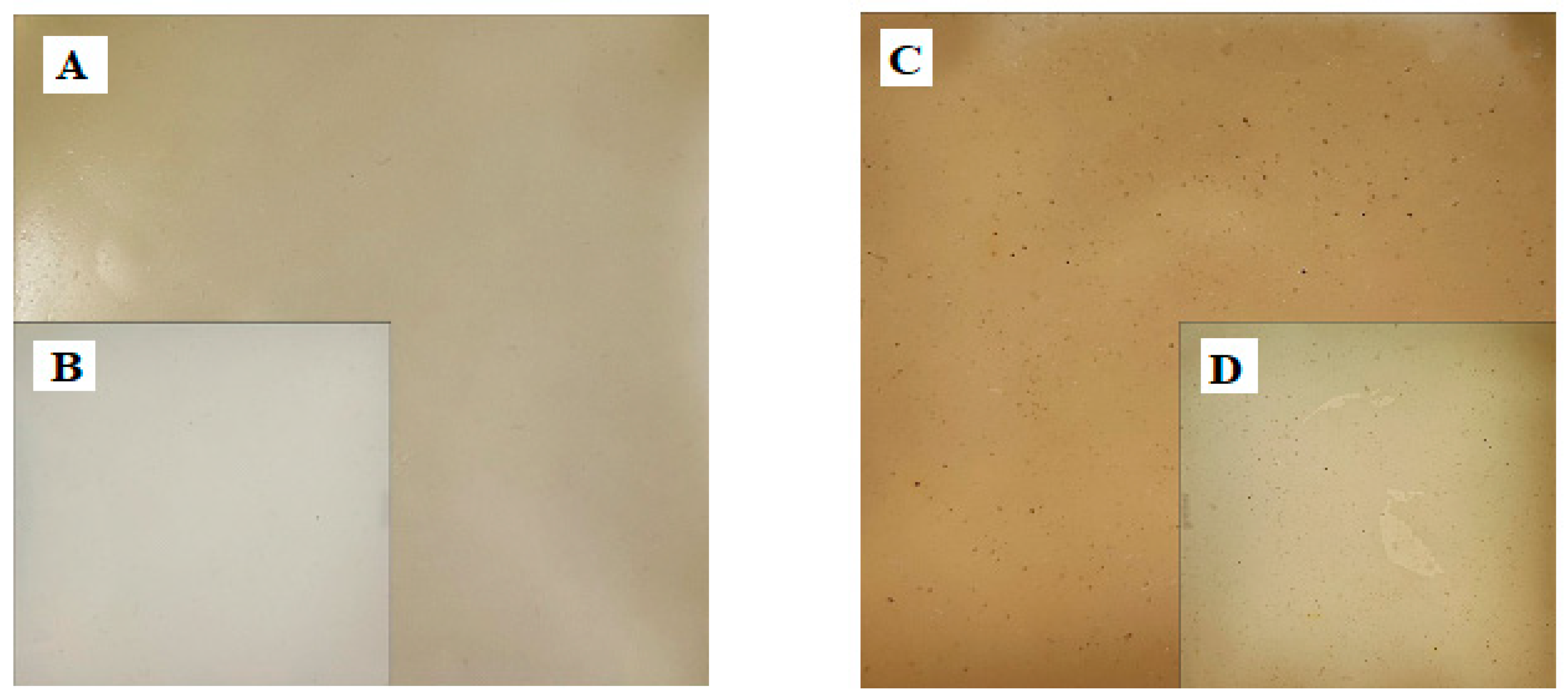
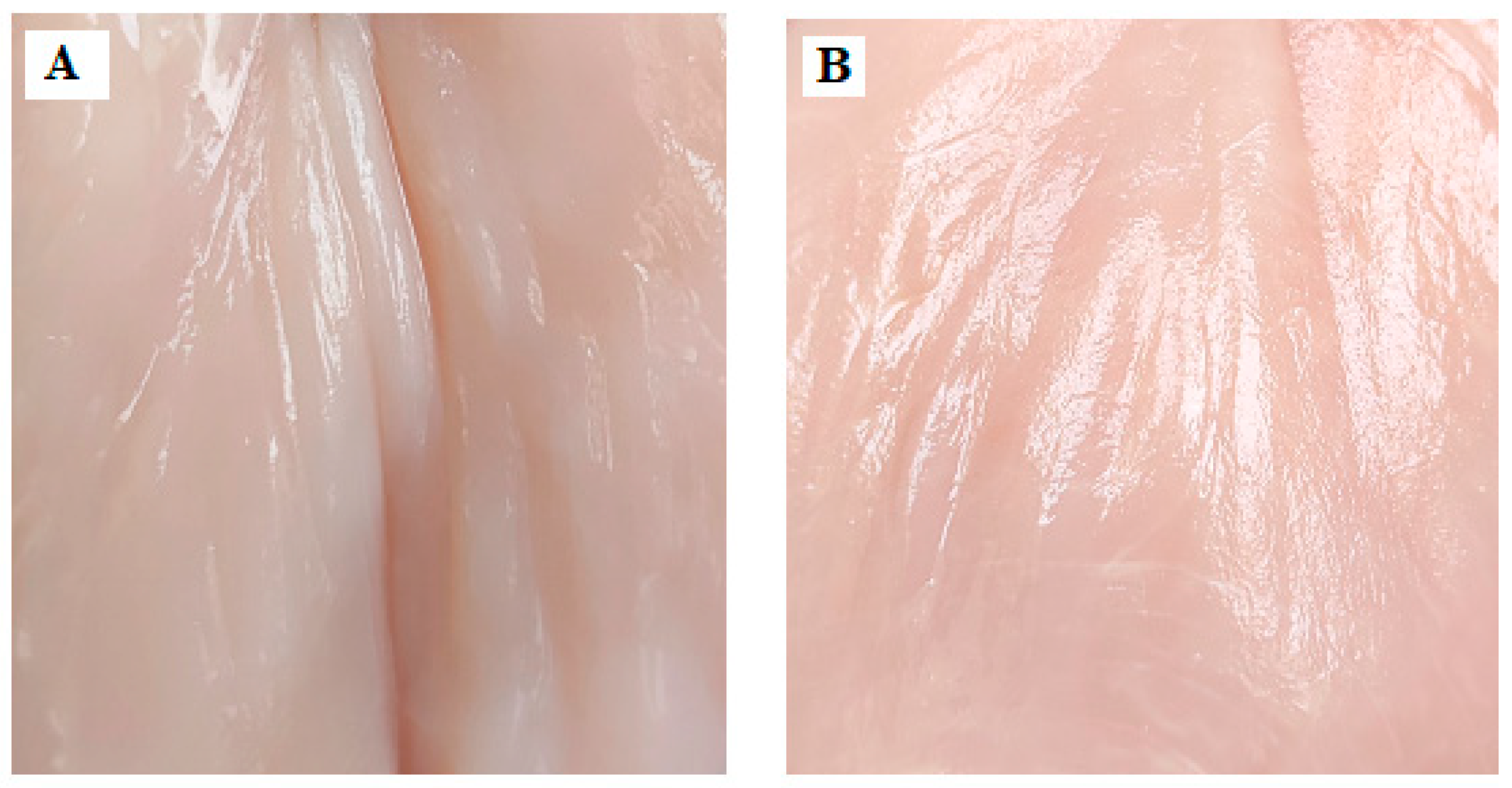
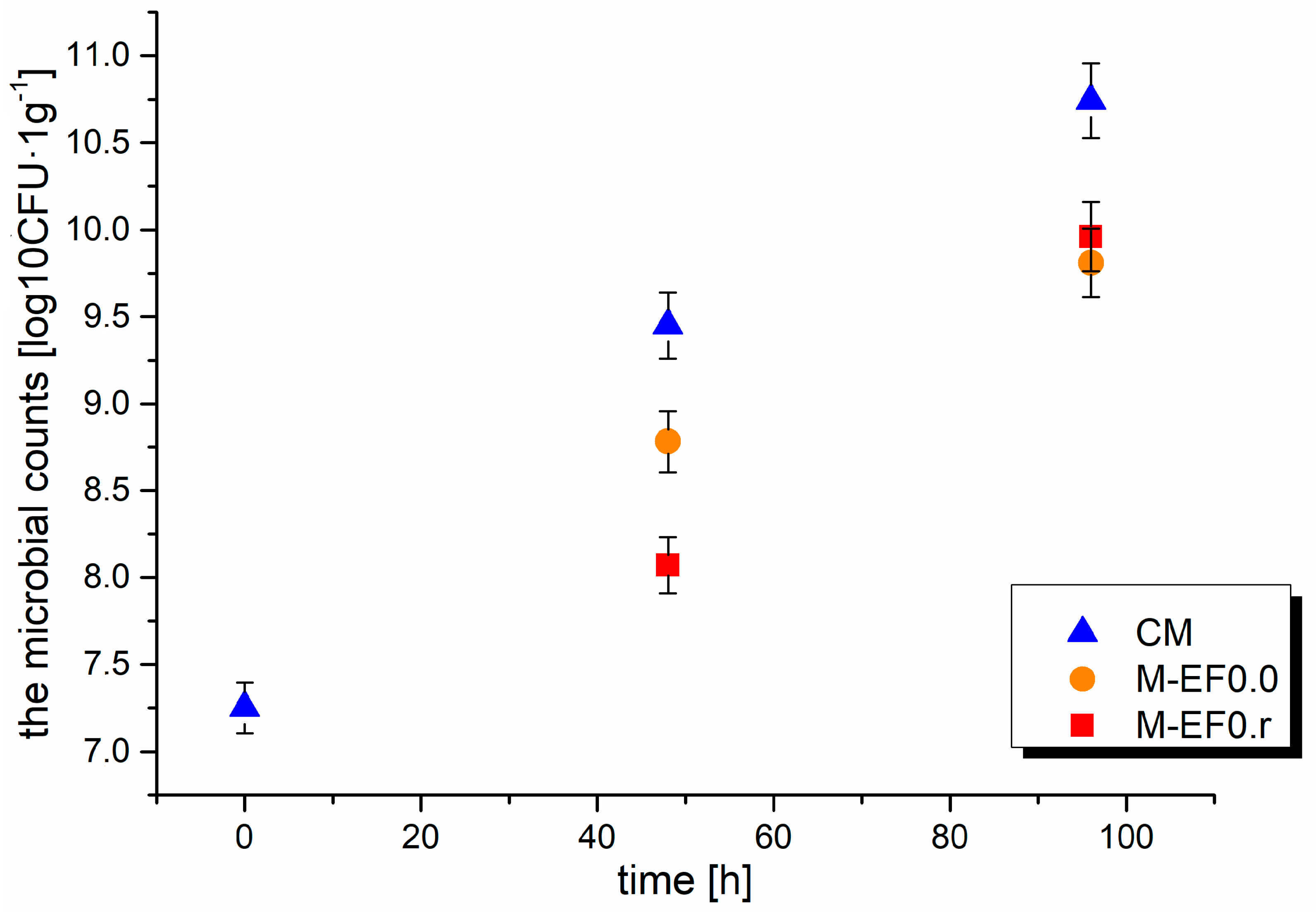

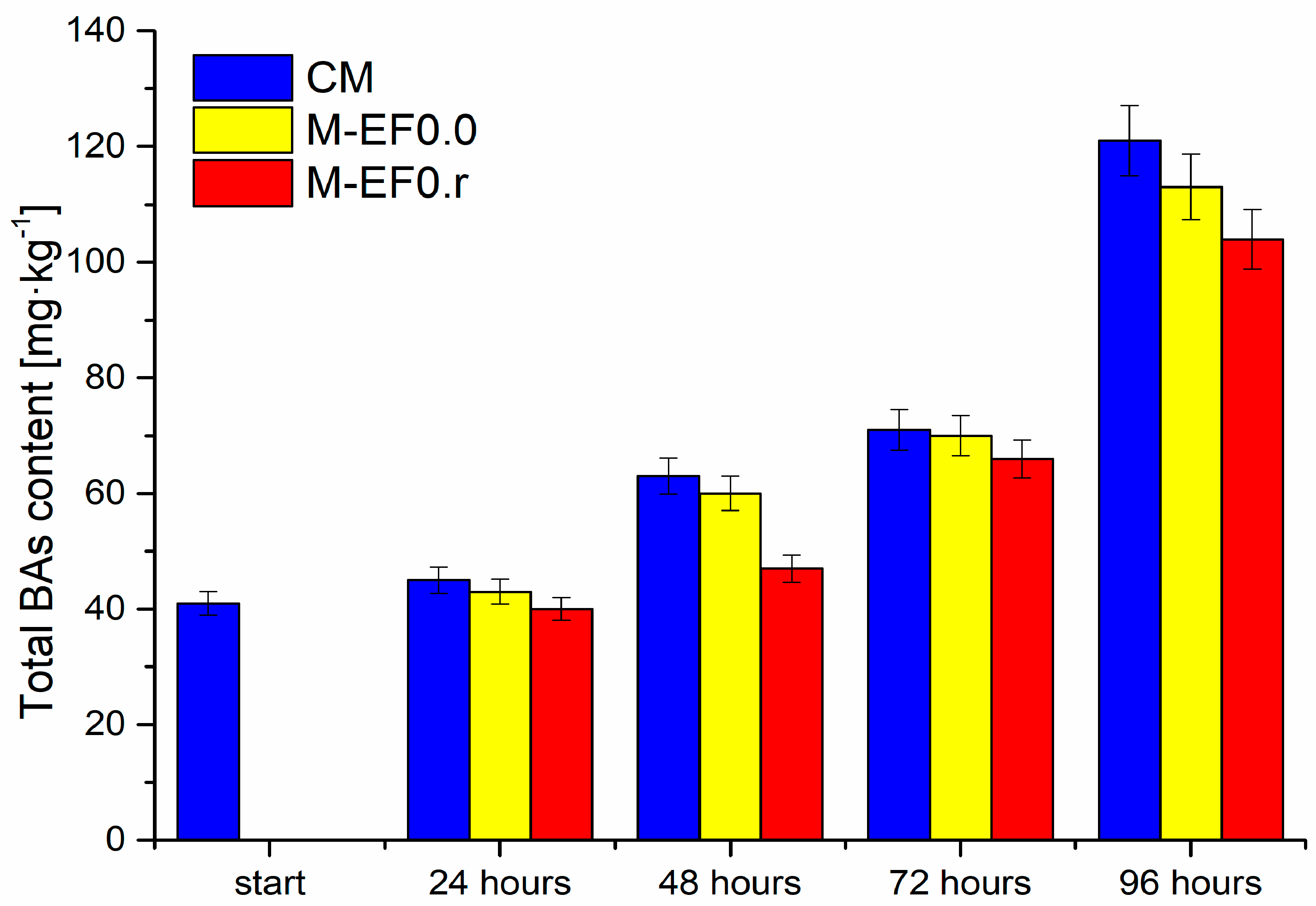
| Code for Coating | CS (%, w/w) | Glycerol (%, w/w) | EO (%, w/w) | Lecithin (%, w/w) | RA (%, w/w) |
|---|---|---|---|---|---|
| CSF | 2.000 | 0.000 | 0.000 | 0.000 | 0.000 |
| EF0.0 | 2.000 | 0.158 | 0.184 | 0.002 | 0.000 |
| EF0.r | 2.000 | 0.162 | 0.191 | 0.002 | 0.282 |
| Property | Units | CSF | EF0.0 | EF0.r |
|---|---|---|---|---|
| Thickness | ×10−6 m | 187 ± 2 | 295 ± 3 | 312 ± 5 |
| Young’s Modulus | MPa | 1458 ± 28 | 28.7 ± 1.3 | 29.3 ± 1.5 |
| Elongation at break | % | 5.7 ± 1.5 | 22.5 ± 2.3 | 20.3 ±1.9 |
| WVP | g mm m−2 day−1 kPa−1 | 7.3 ± 0.2 | 5.8 ± 0.2 | 5.6 ± 0.3 |
| CM | M-EF0.0 | M-EF0.r | ||||
|---|---|---|---|---|---|---|
| TBC | TBARS | TBC | TBARS | TBC | TBARS | |
| TBC | ||||||
| TBARS | 0.8712 | 0.8242 | 0.9668 | |||
| SBAs | 0.9196 | 0.9940 | 0.9292 | 0.9751 | 0.9774 | 0.9990 |
| Sample | Him | Tyr | Trp | Phen | Put | Cad | Spd | Spm | BAI | Spd/Spm |
|---|---|---|---|---|---|---|---|---|---|---|
| CM | nd | nd | nd | nd | nd | nd | 8.99 A ± 0.32 | 31.79 A ± 1.92 | 0 | 0.28 ± 0.02 |
| 24 h | ||||||||||
| CM | 2.88 I ± 0.18 | 2.47 F ± 0.18 | nd | nd | nd | 0.33 J ± 0.03 | 8.85 A,B ± 0.11 | 30.47 C,F ± 0.96 | 5.69 ± 0.25 | 0.29 ± 0.01 |
| M-EF0.0 | 2.69 J ± 0.12 | nd | nd | nd | nd | nd | 8.85 A,B ± 0.17 | 31.25 A,C ± 0.31 | 2.70 ± 0.12 | 0.28 ± 0.01 |
| M-EF0.r | nd | nd | nd | nd | nd | nd | 8.95 A ± 0.19 | 31.44 A,B ± 0.42 | 0 | 0.28 ± 0.01 |
| 48 h | ||||||||||
| CM | 5.26 F ± 0.14 | 2.71 D,E ± 0.16 | nd | nd | 3.59 G ± 0.08 | 14.80 F ± 0.13 | 6.45 G ± 0.11 | 29.97 D,E,F,G ± 0.48 | 26.43 ± 0.21 | 0.21 ± 0.01 |
| M-EF0.0 | 4.12 H ± 0.11 | 2.60 E ± 0.08 | nd | nd | 3.02 H ± 0.10 | 10.80 H ± 0.12 | 8.75 B,C ± 0.16 | 30.70 B,C,D ± 0.14 | 20.54 ± 0.18 | 0.28 ± 0.01 |
| M-EF0.r | nd | nd | nd | nd | 0.95 I ± 0.08 | 5.93 I ± 0.09 | 8.84 A,C,D ± 0.12 | 30.96 A,C ± 0.21 | 6.88 ± 0.14 | 0.28 ± 0.01 |
| 72 h | ||||||||||
| CM | 9.51 B ± 0.10 | 2.78 D ± 0.12 | nd | nd | 7.08 D ± 0.11 | 17.80 E ± 0.13 | 5.61 H ± 0.09 | 28.52 I ± 0.09 | 37.10 ± 0.24 | 0.20 ± 0.01 |
| M-EF0.0 | 5.87 E ± 0.22 | 2.64 E ± 0.10 | nd | nd | 5.15 E ± 0.07 | 20.77 D ± 0.16 | 6.91 F ± 0.12 | 29.66 F,H ± 0.09 | 34.43 ± 0.26 | 0.23 ± 0.01 |
| M-EF0.r | 4.97 G ± 0.11 | 2.60 E,F ± 0.14 | nd | nd | 4.68 F ± 0.11 | 14.40 G ± 0.15 | 8.70 B,D ± 0.14 | 30.52 C,E ± 0.22 | 26.65 ± 0.33 | 0.28 ± 0.01 |
| 96 h | ||||||||||
| CM | 10.8 A ± 0.12 | 5.48 A ± 0.06 | 15.30 A ± 0.09 | 7.20 C ± 0.07 | 27.01 A ± 0.10 | 27.40 A ± 0.10 | 2.45 I ± 0.10 | 25.38 J ± 0.11 | 70.68 ± 0.19 | 0.10 ± 0.01 |
| M-EF0.0 | 7.93 C ± 0.13 | 5.35 B ± 0.05 | 14.51 C ± 0.12 | 8.07 A ± 0.08 | 14.70 B ± 0.12 | 27.18 B ± 0.29 | 6.39 G ± 0.08 | 28.59 I ± 0.80 | 55.17 ± 0.38 | 0.22 ± 0.01 |
| M-EF0.r | 7.66 D ± 0.09 | 4.97 C ± 0.09 | 14.80 B ± 0.11 | 7.93 B ± 0.10 | 8.12 C ± 0.08 | 22.91 C ± 0.14 | 8.15 E ± 0.07 | 29.38 G,H ± 0.65 | 43.66 ± 0.25 | 0.28 ± 0.01 |
Disclaimer/Publisher’s Note: The statements, opinions and data contained in all publications are solely those of the individual author(s) and contributor(s) and not of MDPI and/or the editor(s). MDPI and/or the editor(s) disclaim responsibility for any injury to people or property resulting from any ideas, methods, instructions or products referred to in the content. |
© 2024 by the authors. Licensee MDPI, Basel, Switzerland. This article is an open access article distributed under the terms and conditions of the Creative Commons Attribution (CC BY) license (https://creativecommons.org/licenses/by/4.0/).
Share and Cite
Jastrzębska, A.; Kmieciak, A.; Gralak, Z.; Brzuzy, K.; Nowaczyk, J.; Cichosz, M.; Krzemiński, M.P.; Szłyk, E. Determination of Biogenic Amine Level Variations upon Storage, in Chicken Breast Coated with Edible Protective Film. Foods 2024, 13, 985. https://doi.org/10.3390/foods13070985
Jastrzębska A, Kmieciak A, Gralak Z, Brzuzy K, Nowaczyk J, Cichosz M, Krzemiński MP, Szłyk E. Determination of Biogenic Amine Level Variations upon Storage, in Chicken Breast Coated with Edible Protective Film. Foods. 2024; 13(7):985. https://doi.org/10.3390/foods13070985
Chicago/Turabian StyleJastrzębska, Aneta, Anna Kmieciak, Zuzanna Gralak, Kamil Brzuzy, Jacek Nowaczyk, Marcin Cichosz, Marek P. Krzemiński, and Edward Szłyk. 2024. "Determination of Biogenic Amine Level Variations upon Storage, in Chicken Breast Coated with Edible Protective Film" Foods 13, no. 7: 985. https://doi.org/10.3390/foods13070985
APA StyleJastrzębska, A., Kmieciak, A., Gralak, Z., Brzuzy, K., Nowaczyk, J., Cichosz, M., Krzemiński, M. P., & Szłyk, E. (2024). Determination of Biogenic Amine Level Variations upon Storage, in Chicken Breast Coated with Edible Protective Film. Foods, 13(7), 985. https://doi.org/10.3390/foods13070985









